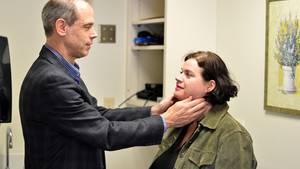Low back pain is the leading cause of disability among working-age adults internationally, confronting 80 per cent of us at some point in our lives. While most seek treatment from a family doctor or walk-in clinic, there’s a minority which takes this affliction to the emergency department.
Dr. Kirk Magee is an emergency medicine physician with the QEII Health Sciences Centre and sees patients with low back pain daily, some unable to wait for an appointment and others in more serious pain than they’re used to.
“Low back pain patients who come into the emergency department are unique,” he says. “Different from those who go to family doctors or walk-in clinics.”
They represent a crowd in more acute discomfort and while most can be treated with pain management, mobilization and the passage of time, some very rare instances of low back pain can be indicative of something more serious.
Because low back pain is considered the domain of family doctors, its relationship with emergency departments across the country is poorly understood. For situations such as heart attacks, says Dr. Magee, there’s a clear procedure that he and his colleagues follow, tailored by the best available science to improve patient outcomes. No such roadmap exists for low back pain, however. The methods of treatment vary from patient to patient, even physician to physician.
“When patients are seen by a physician, everyone has their own recipe for treating low back pain,” says Dr. Magee. “As physicians we all think we’re right and doing the best thing, but I suspect there’s a lot of variability and to me, that probably means we don’t know the right answer.”
This lack of cohesion in the emergency department can lead to unnecessary or inappropriate treatment of patients, wasted resources and even slower recovery, says Dr. Magee. And with a full three per cent of his patients coming in with this condition each year, it was time to fill the void.
Dr. Jill Hayden is an affiliate scientist at the QEII and an associate professor with Dalhousie University’s Department of Community Health and Epidemiology. Having spent much of her career studying low back pain, she was just the person to fill this gap in literature.
“There’s been very little research on low back pain in the emergency department because that’s not where you expect someone with back pain to go,” she says.
Since their chance meeting at a conference in Quebec City, Drs. Hayden and Magee have partnered on a series of studies to better appreciate this elusive problem. With the aid of three consecutive
Their funding thus far has helped formally identify the shortcomings of emergency response to low back pain, such as variability in the treatment and recommendations of physicians, the overuse of diagnostic imaging such as X-rays, which are rarely necessary and can slow patient recovery, and the expectation among patients that emergency departments will identify the cause of their pain, when its primary function is actually to rule out anything serious. With an improved understanding of the challenges they face and a third TRIC grant forthcoming, Dr. Magee is getting closer to building his roadmap.
“I like to develop an evidence-based process that provides good advice for patients, gives good treatment recommendations and hopefully, meets some of their expectations,” he says.
TRIC grants are relatively small and meant to encourage improvements to local practice, says Dr. Hayden. But research such as this has national applications and thanks to this groundwork they, along with a large interprovincial team, were recently awarded a national grant with the Canadian Institutes of Health Research worth more than $780,000.
About seven per cent of low back pain patients entering the emergency department are actually suffering from something more serious, such as a compression fracture, cancer, discitis, and others, but separating these few from the majority without extensive testing is as yet beyond their power. It’s hoped this national grant will fund a larger study identifying red flags for physicians to recognize and understand how they might be evaluated in relation to each other.
“That’s part of what we’re looking at,” says Dr. Magee. “How do we effectively rule these things out while, at the same time, being conscious that we can’t do tests and images on everyone?”








